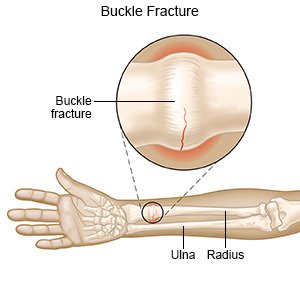Buckle Fracture
Medically reviewed by Drugs.com. Last updated on Aug 4, 2025.
What is a buckle fracture?
A buckle fracture is a break that does not go completely through the bone. One side of the bone buckles (bulges) when pressure is applied to the other side of the bone. A buckle fracture is also called a torus fracture. Buckle fractures usually occur in the forearm.
 |
What are the signs and symptoms of a buckle fracture?
- Pain or tenderness
- Swelling or bruising around the injury
- Trouble moving, touching, or pressing on the injured area
How is a buckle fracture diagnosed and treated?
X-rays will show if your child has a buckle fracture. He or she may need any of the following:
- A support device , such as a cast or splint, may be needed to support and protect your child's bone while it heals. It will decrease movement of the injured area and allow it to heal. Your child will need to wear the support device for 3 to 4 weeks.
- NSAIDs , such as ibuprofen, help decrease swelling, pain, and fever. This medicine is available with or without a doctor's order. NSAIDs can cause stomach bleeding or kidney problems in certain people. If your child takes blood thinner medicine, always ask if NSAIDs are safe for him or her. Always read the medicine label and follow directions. Do not give these medicines to children younger than 6 months without direction from a healthcare provider.
- Acetaminophen decreases pain and fever. It is available without a doctor's order. Ask how much to give your child and how often to give it. Follow directions. Read the labels of all other medicines your child uses to see if they also contain acetaminophen, or ask your child's doctor or pharmacist. Acetaminophen can cause liver damage if not taken correctly.
How can I manage my child's symptoms?
- Have your child rest as much as possible. Do not let your child put pressure on the injured area or move it. Ask your child's healthcare provider when he or she can return to sports and other activities.
- Apply ice on your child's injury for 15 to 20 minutes every hour or as directed. Use an ice pack, or put crushed ice in a plastic bag. Cover it with a towel before you place it on your child's skin. Ice helps decrease swelling and pain.
- Elevate the area above the level of your child's heart as often as you can. This will help decrease swelling and pain. Prop the area on pillows or blankets to keep it elevated comfortably.

When should I seek immediate care?
- Your child's pain gets worse, even after he or she rests and takes medicine.
- Your child's hand or fingers feel numb.
- Your child's skin over the fracture is swollen, cold, or pale.
- Your child cannot move his or her hand or fingers.
When should I call my child's doctor?
- Your child's brace or splint becomes wet, damaged, or comes off.
- You have questions or concerns about your child's condition or care.
Care Agreement
You have the right to help plan your child's care. Learn about your child's health condition and how it may be treated. Discuss treatment options with your child's healthcare providers to decide what care you want for your child. The above information is an educational aid only. It is not intended as medical advice for individual conditions or treatments. Talk to your doctor, nurse or pharmacist before following any medical regimen to see if it is safe and effective for you.© Copyright Merative 2025 Information is for End User's use only and may not be sold, redistributed or otherwise used for commercial purposes.
Learn more about Buckle Fracture
Care guides
Further information
Always consult your healthcare provider to ensure the information displayed on this page applies to your personal circumstances.
